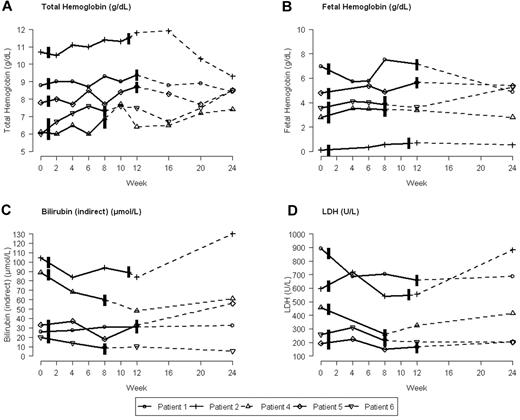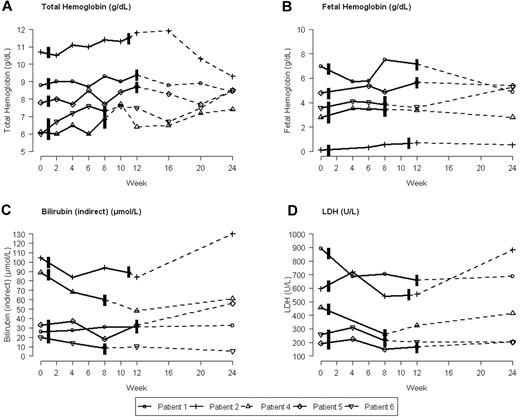Abstract
Ineffective erythropoiesis, the hallmark of β-thalassemia, is a result of α/non-α globin chain imbalance.1 One strategy to redress globin-chain imbalance is to induce γ-globin gene (HBG) expression. Repression of HBG in adult erythroid cells involves DNA methylation and other epigenetic changes. Therefore, the cytosine analog decitabine, which can deplete DNA methyltransferase 1 (DNMT1), can potentially activate HBG. In 5 patients with β-thalassemia intermedia, a dose and schedule of decitabine intended to deplete DNMT1 without causing significant cytotoxicity (0.2 mg/kg subcutaneous 2 times per week for 12 weeks) increased total hemoglobin from 7.88 ± 0.88 g/dL to 9.04 ± 0.77 g/dL (P = .004) and absolute fetal hemoglobin from 3.64 ± 1.13 g/dL to 4.29 ± 1.13 g/dL (P = .003). Significant favorable changes also occurred in indices of hemolysis and red blood cell densitometry. Consistent with a noncytotoxic, differentiation altering mechanism of action, the major side effect was an asymptomatic increase in platelet counts without erythrocyte micronucleus or VDJ recombination assay evidence of genotoxicity. This study was registered at www.clinicaltrials.gov as #NCT00661726.
Introduction
β-Thalassemia intermedia, a disease that causes progressive end-organ failure and early death, is a global healthcare problem of increasing importance.1 The hallmark of the disease is ineffective erythropoiesis (active erythropoiesis with premature red blood cell [RBC] death). The underlying cause is decreased synthesis of β-globin, from inherited genetic abnormalities at the β-globin gene (HBB) or in distal regulatory elements. The β-globin deficiency causes α/non-α globin chain imbalance, precipitation of the excess α-globin chains, and erythrocyte precursor destruction. Importantly, a milder clinical course occurs in patients with higher intrinsic synthesis of γ-globin (fetal hemoglobin [HbF]), the non-α globin chain that is usually highly expressed only during fetal stages of development. In β-thalassemia patients who continue to express HbF into adulthood, there is more effective erythropoiesis and a better prognosis.2 Accordingly, a research goal has been to recapitulate this phenotype by pharmacologic means. Currently, hydroxyurea remains the only drug approved (Food and Drug Administration) for disease modification of a hemoglobinopathy. In β-thalassemia intermedia, responses to hydroxyurea are more modest and unpredictable than in sickle cell disease.3 Importantly, hydroxyurea-induced activation of the γ-globin gene (HBG) is associated with local DNA hypomethylation.4 Because even hydroxyurea may have to produce epigenetic changes to activate HBG, albeit indirectly via antimetabolite effects and cytostasis/cytotoxicity, it may be worthwhile to investigate drugs that directly inhibit chromatin-modifying enzymes, for example, DNA methyltransferase 1 (DNMT1), that silence HBG (supplemental References, available on the Blood Web site; see the Supplemental Materials link at the top of the online article). The deoxycytidine analog decitabine can be used to deplete DNMT1 and alter epigenetics and gene expression. Small studies in sickle cell disease suggest that direct epigenetic modification with decitabine can produce major individual HbF and total hemoglobin (Hb) increases in the majority of patients treated.5,6 In this first pilot study in β-thalassemia intermedia of a dose and schedule of decitabine intended for direct, noncytotoxic epigenetic effects, the objective was to provide the early data that might guide future, more definitive, studies of this approach.
Methods
Six patients (Table 1; supplemental Table 1) were enrolled into this pilot (phase IIa) study. Decitabine 0.2 mg/kg (reconstituted in 5 mL water or saline for injection) was administered subcutaneously daily on the same 2 consecutive days each week for 12 weeks. One patient withdrew from study after week 2 because of fatigue requiring transfusion. Two patients were treated for 12 weeks, 1 patient for 11 weeks, and 2 patients for 8 weeks. Various treatment durations were the result of treatment-induced platelet count increases to > 1000 × 109/L, requiring therapy interruption per protocol. In addition to standard clinical and clinical laboratory evaluations, measurements of RBC deformability, density, and phosphatidylserine exposure, and micronucleus and VDJ recombination assays, were performed using previously described methods.7-9 HbF was measured by cation exchange high performance liquid chromatography. The protocol was approved by the Thalassemia Clinical Research Network Data and Safety Monitoring Board and by the ethical review boards of all participating Thalassemia Clinical Research Network institutions. Written informed consent was obtained from all the participants in accordance with the Declaration of Helsinki.
The primary efficacy endpoint was an increase in total Hb of 1.5 g/dL or more from baseline to peak (baseline = mean from 3 pretreatment weekly samples; peak = highest level in biweekly samples taken between weeks 2-12 inclusive). Linear regression after adjusting for time duration was used to test the mean difference between baseline and follow-up values (peak, nadir, 12 weeks; SAS Version 9.2, SAS Institute; and R2.11.1 http://www.r-project.org). P values < .05 were considered statistically significant. The study was powered (n = 8, although final n = 6) to have 90% probability of observing at least 1 participant achieving the primary endpoint for true efficacy rates as low as 25% (highly detailed in supplemental Methods).
Results and discussion
The primary outcome, an increase in Hb of ≥ 1.5 g/dL above baseline, was achieved in 2 of 5 evaluable patients. In the group overall, Hb increased from baseline 7.88 ± 0.88 g/dL to peak 9.04 ± 0.77 g/dL (P = .004; Table 1). Absolute HbF increased from 3.64 ± 1.13 g/dL to 4.29 ± 1.13 g/dL (P = .003). Trends for increasing Hb and HbF were noted in all 5 patients during treatment (Table 1; Figure 1). Suggesting decreased hemolysis and more effective erythropoiesis, indirect bilirubin declined from baseline 3.2 ± 1.0 mg/dL to nadir 2.2 ± 0.8 mg/dL (P = .045; Table 1; Figure 1). There was a nonsignificant trend for decreasing serum lactate dehydrogenase, from 479.4 ± 125.8 U/L to 362.8 ± 100.4 U/L (P = .083; Table 1; Figure 1). There was a significant decrease in the absolute reticulocyte count from 157.0 ± 14.5 × 109/L to 123.0 ± 13.2 × 109/L (P = .039; Table 1; supplemental Figure 1). There was a nonsignificant trend for decreasing erythropoietin levels from 147.4 ± 39.7 mIU/mL to 103.6 ± 27.8 mIU/mL (P = .177). There was a significant shift toward normalization of RBC Hb concentration (P = .022; supplemental Table 2; supplemental Figure 2). There was a statistically nonsignificant decrease in RBC phosphatidylserine exposure (supplemental Table 2; supplemental Figure 2). There was no significant change in maximum RBC deformability (supplemental Table 2; supplemental Figure 2).
Changes in total hemoglobin, absolute HbF, indirect bilirubin, and serum lactate dehydrogenase during (bold lines) and after (dashed lines) decitabine treatment. The vertical black lines indicate the time of first and last decitabine injections in each patient. Some patients were treated for < 12 weeks because platelet counts increased above a priori demarcated levels.
Changes in total hemoglobin, absolute HbF, indirect bilirubin, and serum lactate dehydrogenase during (bold lines) and after (dashed lines) decitabine treatment. The vertical black lines indicate the time of first and last decitabine injections in each patient. Some patients were treated for < 12 weeks because platelet counts increased above a priori demarcated levels.
Platelet counts increased from 585.2 ± 90.6 × 109/L to 940.2 ± 184.3 × 109/L (P = .007; Table 1; supplemental Figure 1). Platelet increases were the only adverse event definitely related to therapy. Baseline platelet counts in these patients were already elevated. No clinical events were associated with these increases. In the only nonsplenectomized patient, platelet increases were minimal (from 233 to 296 × 109/L). There was a nonsignificant downward trend in neutrophils, from 6.51 ± 1.20 × 109/L to 3.36 ± 0.63 × 109/L (P = .069; Table 1; supplemental Figure 1). Quantitative in vitro assays for mutagenicity, specifically enumeration of illegitimate VDJ recombination events, and micronuclei within early reticulocytes did not identify significant changes between baseline and 24-week values (supplemental Figure 2).
Decitabine-induced shifts in differentiation include increased erythropoiesis and megakaryopoiesis.5,10 Therefore, increases in platelet counts were expected, and the interruption in study drug administration was per-protocol mandated procedures. Because patients with thalassemia intermedia, especially those after splenectomy, have a higher risk for venous and arterial thrombosis, this side effect is a concern. Although it is intuitive to expect an association between platelet count and thrombosis risk, this has not been evident in a number of studies, whereas qualitative RBC defects (or qualitative platelet defects in myeloproliferative disease) probably have a role (supplemental References).5,11-18 Notably, in a sickle cell disease study using a similar regimen of decitabine, improvement in multiple indices of RBC pathology was accompanied by improvement in multiple markers of coagulation pathway activity, despite platelet count increases to > 800 × 109/L.5 Thus, it is possible that decitabine-induced improvements in RBC phenotype could reduce thrombophilia despite concurrent platelet count increases. To answer this question in β-thalassemia, coagulation pathway evaluation should be a component of future studies.
For life-long disease modification, pharmacologic induction of HbF must have an excellent safety profile. One concern with hydroxyurea or nucleoside analog therapy is the possibility of mutagenesis and hence carcinogenesis. Unlike some other cytosine analogues, for example cytarabine or gemcitabine, the sugar moiety of decitabine is unmodified. Therefore, at low concentrations, decitabine does not terminate DNA chain elongation19,20 and can deplete DNMT1 without causing significant DNA damage or cytotoxicity, both in vitro and in vivo.5,19-23 In addition to decreased mutagenic risk, this noncytotoxic mechanism of action of low-dose decitabine may be more sparing than cytotoxic hydroxyurea of bone marrow precursors, required to sustain vigorous compensatory erythropoiesis.10,24-26 A definite concern with decitabine, as with hydroxyurea, is the possibility of teratogenicity (pregnancy category D).
Decitabine can be used to deplete DNMT1 without major cytotoxic effects, to directly counter epigenetic mechanisms that silence HBG. Hb and HbF increased in all 5 evaluable patients during treatment, with Hb increases of ≥ 1.5 g/dL in 2 patients. Significant improvements occurred in indices of hemolysis and RBC pathology. Consistent with a noncytotoxic, differentiation-altering mechanism of action, the prominent side effect was an increase in the platelet count, without significant changes in the erythrocyte micronucleus and VDJ recombination assays for genotoxicity. Accordingly, this treatment approach is mechanistically distinct from antimetabolite-based therapy with hydroxyurea, the current standard agent used for HbF induction. However, conclusions from this small, pilot study are limited. Therefore, the potential of this approach requires further clinical evaluation.
The online version of this article contains a data supplement.
The publication costs of this article were defrayed in part by page charge payment. Therefore, and solely to indicate this fact, this article is hereby marked “advertisement” in accordance with 18 USC section 1734.
Acknowledgments
This work was supported by the National Institutes of Health, National Heart, Lung, and Blood Institute (NHLBI, cooperative agreement U01 HL065238).
Its contents are solely the responsibility of the authors and do not necessarily represent the official views of the NHLBI.
National Institutes of Health
Authorship
Contribution: N.F.O., Y.S., V.T., J.K., R.E.W., F.A.K., and E.P.V. designed and performed research; H.-Y.K. and F.L.T. analyzed data; and N.F.O., Y.S., V.T., J.K., R.E.W., F.A.K., H.-Y.K., F.L.T., and E.P.V. and wrote the paper.
Conflict-of-interest disclosure: The authors declare no competing financial interests.
This is publication number 21 of the Thalassemia Clinical Research Network. A list of Thalassemia Clinical Research Network member institutions and staff appears in the supplemental Appendix.
Correspondence: Yogen Saunthararajah, 9500 Euclid Ave, R40, Cleveland, OH 44195; e-mail: saunthy@ccf.org.



